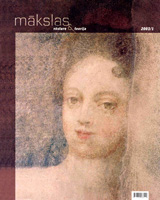Kabiles "Dzīru nams" un tā grīdas flīzes
The Kabile "Feast House" and its Floor Tiles
Author(s): Ilmārs DirveiksSubject(s): Essay|Book Review |Scientific Life
Published by: Mākslas vēstures pētījumu atbalsta fonds
Keywords: Kabile manor; architecture; manor houses; floor tiles
Summary/Abstract: This material focuses on a two-floor building located at the centre of the Kabile (Kabillen) manor complex in Kurzeme. The peculiar name "Roe House" seemingly points to the function of keeping roes in the building. The brick building with four-pitched, tiled roof is a unique typological and architectonic example dating from the 17th century. The ground floor is vaulted and contains a decorated part of stove heating system, so far called a fire-place and dating from the 2nd half of the 17th century. The first floor features a wooden ceiling above the beam construction, later complemented by decorative ceiling made of yellow profiled boards. The floor covered with clay tiles has survived from the 2nd half of the 17th century. Several tiles feature imprints where two subjects can be discerned. One consists of two figures, a tree trunk and two dogs or wolves. The other displays a knight on horseback with a whip in his hands. The origins of imprints are unclear. They could be made by some 16th-century wooden object because sides of imprints have retained signs of wooden tissue. The Kabile "Feast House" has no close analogies in Latvia. After the Nordic War, during the 2nd quarter of the 18th century, manor ensembles acquired more open layout. The new manor house in Kabile was more representative and adequate to the new circumstances - the old Feast House became outdated and presumably was used for household needs of storing grain and spirits. In the 1950s and 1960s mechanic workshops were housed in this building. The original window openings of the first floor were broken out. Additional openings caused wall deformation and water tank set up in the loft seriously damaged the roof construction. And yet the building will persist because since 2002 it has a proprietor who has carried out the most urgent restoration works. This object is still to be explored in respect to the history of the Kabile manor, especially concerning the less-known 17th century and the landlord Berch's family who was the former owner.
Journal: Mākslas Vēsture un Teorija
- Issue Year: 2003
- Issue No: 01
- Page Range: 39-41
- Page Count: 3
- Language: Latvian
- Content File-PDF

